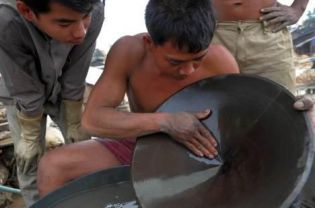Cambodian Gold Rush Lures Foreign Giants
Published by MAC on 2011-06-28Source: AFP
Cambodian Gold Rush Lures Foreign Giants
AFP
23 June 2011
O'Clor, Cambodia. Squinting in the harsh midday sun, Ry Kuok emerges slowly with a bag of rocks on his back from a hand-dug mine in a remote corner of Cambodia known as the "Gold Forest".
 |
| A Cambodian man looking for gold in Mondulkiri province Source: AFP |
He's one of hundreds of prospectors searching for the yellow metal in the isolated village of O'Clor in northeast Mondulkiri province, where a modern-day gold rush is threatened by the arrival of foreign mining giants.
On a good day, the 29-year-old can earn about $12.50. Not bad in a country where a third of the population survives on less than a dollar a day.
The work is dangerous, difficult - and completely illegal.
Carried out by tens of thousands of Cambodians across the impoverished country, the practice has been quietly tolerated by the government for decades.
But that is about to change as companies move in and invest millions of dollars to develop a gold mining industry, leaving no room for illegal prospectors.
"I don't expect we can mine here for much longer," said Kuok as he sifted through his dirty rocks looking for any glints of gold.
"We have been told that a company has bought the area and we are not allowed to dig deeper tunnels."
Cambodia is known to host at least 19 gold deposits that have attracted the interest of mining firms from Australia, China, South Korea and Vietnam.
Industry experts estimate the country is about five years away from large-scale gold extraction but the true extent of the nation's gold assets remains unclear.
In what was hailed as a promising discovery, Australian miner OZ Minerals last year announced a 605,000-ounce gold find in Mondulkiri province but it recently said further drilling projects had disappointed.
Even so, Richard Stanger, president of the Cambodian Association of Mining and Exploration Companies, said the mining industry "could be a major contribution to the economy of Cambodia in the future."
The illegal O'Clor mine is located in Prey Meas, which translates as the "Gold Forest", and is a treacherous five-hour drive from the province's main town of Sen Monorom.
Stripped of its vegetation to make way for a large pit, the mining village's brown, barren landscape is dotted with wooden shacks, piles of litter and shallow pools - a sharp contrast to the green and hilly surroundings.
But to miners like Kuok, whose family moved to the area in 1981, it is home. For now.
The government has granted a Chinese firm the rights to search for the precious metal in the forest and it has already begun its exploration work right next to the O'Clor mine, which lies in the firm's concession area.
A guard at the site said the company's name was Rong Chheng but few details have been made public about the firm or its concession agreement, a lack of transparency that critics say is typical for the country's mining sector.
"There is still very little information about the process of allocation of mining rights in Cambodia and what payments are made for their receipt," said George Boden from environmental watchdog Global Witness.
Gold prices have struck record highs on international markets and even broke through the $1,500 an ounce barrier in April as investors sought a safe haven in the face of economic uncertainty and high inflation.
Most of the illegal miners in the "Gold Forest" earn several hundred dollars a month selling their specks of gold to local traders, income that has been boosted by the soaring bullion price.
"We can survive because gold is expensive now," said 51-year-old Sum Sokhon, raising his voice over the noise of his stone-crushing machine.
But life in an illegal gold mine town is far from easy. "The area is so dirty," said Sokhon. "We worry about our health. People get sick a lot."
Hazardous materials such as mercury or cyanide are often used in the gold extraction process in illegal mines and can pose serious health risks, said Glenn Kendall, an advisor for the United Nations Development Program (UNDP) in Cambodia.
The chemicals can cause anything from headaches to damage to the nervous system, according to experts.
There are also few safety measures in place and mine blasts and tunnel collapses have claimed lives in O'Clor over the years.
"Small-scale mining is a dangerous occupation," said Kendall, adding that the choice to become an illegal miner was usually driven by poverty.
He said the fate of the illegal workers was in the hands of the government, but with the right regulation, small--scale miners could co-exist with the professional mining companies.
Kong Pisith, chief of Mondulkiri's industry, mining and energy office, said the "Gold Forest" miners would eventually have to halt their activities.
"When the extraction starts, they can't mine here anymore. They may become workers for the companies or they will have to change jobs," he said.
Prospectors like Sokhon fear the Chinese mining firm will reap the rewards of their hard work.
"Cambodian people found the gold, but the company is getting the gold," he said.